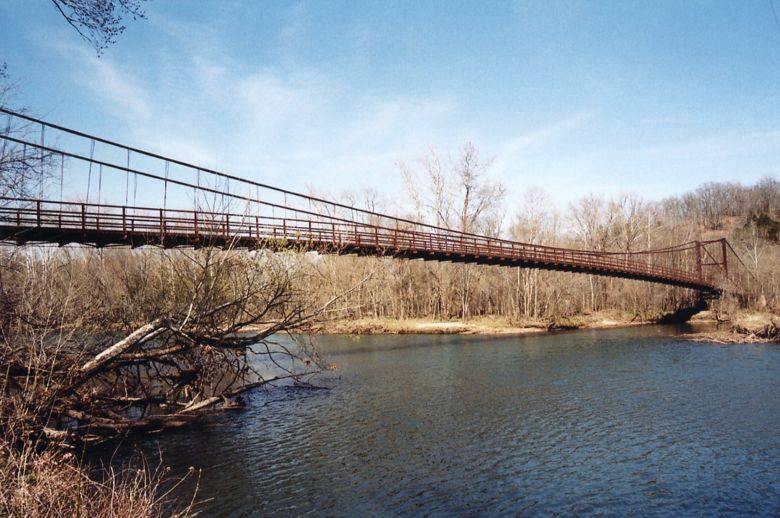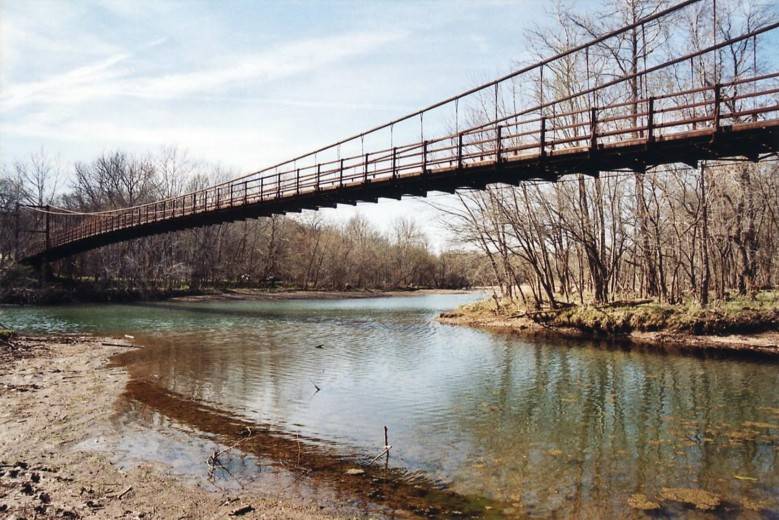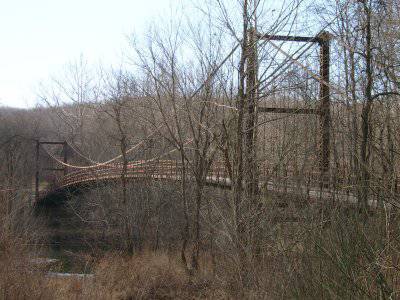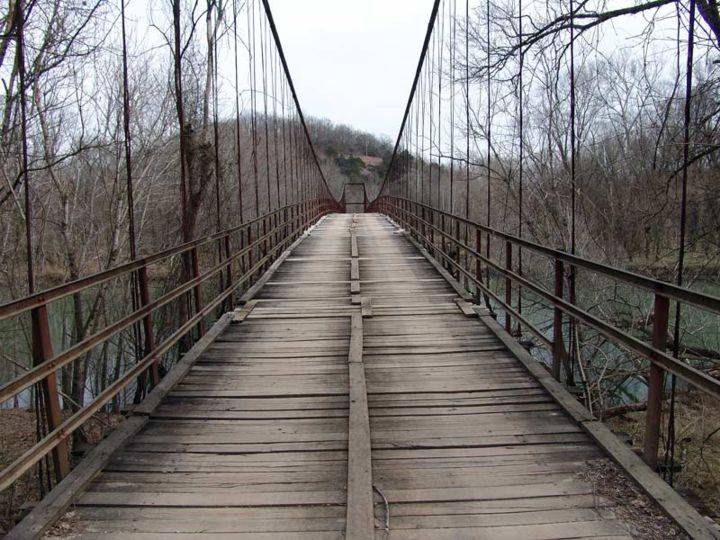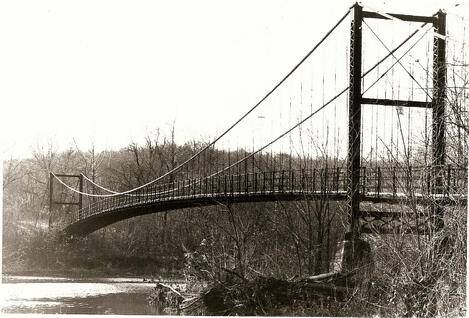Joseph A. Dice, the Bridge Builder
by Kelly Warman-Stallings
Suspension bridges have been prevalent for centuries, but it was not until the mid-19th century that they were used for “anything heavier than horse-and-foot traffic”. By the late 1800s, the suspension bridge increased its popularity and many bridge builders soon discovered it was extremely economical; the swinging bridge was well suited to wide clearances and could be constructed of readily available materials, such as local timber and creek gravel. The common version of these vernacular bridges often lacked the technologies of the era, such as twisted wire and steel beams, but by the early 1900s, suspension bridges had become commonplace for vehicular traffic.
The Joseph A. Dice suspension bridges were a fine example of vernacular bridges of the early 1900s. Mr. Dice, who originally hailed from Warsaw, Benton County, Missouri, supervised the construction of seven bridges throughout Miller County between 1905-1930. He designed bridges to span substantial streams, creeks and rivers, as well as produced small bridges for farmers on private property. Inherently lacking some technical sophistication, the Dice suspension bridges in central Missouri were built from experience and for the needs of local people. At one time there were numerous Dice bridges scattered throughout Missouri with most wire-cable suspensions being housed in Miller and Benton Counties. Unfortunately, most of these historic bridges have been lost to either neglect, flooding, and/or replacement by concrete and steel.
He started his bridge-building career as a young apprentice to Dr. Daniel M. Eddy in 1895 on the Stockton Bridge in Cedar County, Missouri. In 1905, the first public toll bridge that spanned the Osage River in Miller County, was built at Tuscumbia. Mr. Dice was awarded the contract from the Tuscumbia Bridge Company to erect the 618-foot swinging bridge. In 1932, the Dice bridge was replaced with a modern truss bridge [of that era], which completed State Highway-MO 17 through Miller County.
According to the 1940 United States Census, Joseph Dice had a limited education that extended to the 4th grade, but this did not hinder him from achieving success. What sets this self-educated engineer apart from his competitors of the early 1900s was that Mr. Dice’s method of measuring the bridge was done with a ball of twine; no blueprints were involved, instead, he ingeniously eyeballed the place where the bridge was to be built and assessed how much material he needed and what configuration the bridge should have. He was a skillfully pragmatic man with a mathematical eye and a calculating brain. His method of calculating a bridge’s dimensions was noticeably different from other builders of his day and consisted of using a ball of twine to get his mathematical equations precise. As Peggy Smith Hake noted, “We are told Mr. Dice could tell by the ‘feel’ of the wire if the tension was right.” He built a regional reputation as a builder of suspension bridges, as Robert Hayden acclaimed, an “almost legendary reputation”.
Mr. Dice was also credited with building wooden suspension bridges; he used local supplies of wood and concrete and only purchased the strands of wire for the cables. “For the steel suspension bridges,” Tom Chesser noted, “he ordered kits from a bridge company in Pennsylvania and just strung the cable and hung the steel “I” beams. The suspension bridge kits were less expensive than those for the steel truss bridge type since less steel was used in the suspension type bridge.”
Not only was Joseph A. Dice an enterprising engineer of bridges, but at various times throughout his life, he served Benton County, Missouri as County Highway Engineer and County Surveyor. Yet, building his bridges seemed to have been Dice’s favorite career endeavor.
As noted earlier, Joseph A. Dice was a builder who basically carried the blueprints in his head, having no official drafts, engineering plans or written instruction. During the era of Dice’s bridge building career, bridge projects were a contribution to connecting people to other places for both social and commerce reasons. Formalized engineering standards did not exist at that time. Peggy Smith-Hake noted, “When the highway department required blueprints for construction, Mr. Dice retired as a bridge builder!”.
Joseph A. Dice, a man of unique talent when it came to building bridges, most likely knew he could not compete for state contracts. With the impounding of the Osage River it increased the demand for the heavy-duty truss bridge. Without a doubt, Dice realized this was the beginning of the wire-cable suspension bridge’s demise, and most likely was analytically instrumental in Dice’s final decision for retiring his artisan skills.
Seven suspension bridges in Miller County were included in Dice’s bridge building endeavors:
1. Tuscumbia Toll Bridge – built 1905; replaced 1932
Located at Tuscumbia, the original Tuscumbia Toll Bridge was a 618.0 feet swinging suspension bridge that once spanned the Osage River. Some of the notably characteristic features of this bridge was its wooden towers and wooden rails. It was torn down and replaced with a historic truss bridge in 1932.
2. Grand Auglaize Bridge – built ca. 1920-1931
Located near Brumley, the Grand Auglaize Bridge, a 500 foot swinging bridge that spans the Grand Auglaize Creek, is the last originally constructed vernacular bridge in Miller County (Added to the National Registry of Historic Places, October, 2020).

3.Kemna Bridge – built 1924; rehabilitated 1978
Located near St. Elizabeth, Kemna Bridge retains a historic significance, but does not retain its original integrity. The bridge was modified from its original design with the majority of its original materials being replaced (ie: steel towers replaced the original wooden towers, the original concrete pedestals were replaced with modern concrete pedestals, the steel cables reinforced with new cables and the historic timber flooring was replaced with modern steel).

4. Buetcher Bridge – built ca. 1925; replaced 2011
Located southwest of St. Anthony, the original Buetcher Bridge was a 141.0 feet swinging bridge that once spanned Tavern Creek. The character-defining feature of this Dice bridge was it only housed one small steel tower, where the cables attached to thick dual timber posts at the opposite end. A modern concrete bridge was installed in 2011.

5. Kliethermes Bridge-built c/1925; rehabilitated 1988; demolished 2008
Once located northwest of St. Anthony, the original Kliethermes Bridge, a 215.9 feet swinging bridge, no longer exists. What set this bridge apart from other Dice bridges in Miller County was it housed a small steel tower at one end and two stone pillars at the other end of the bridge. It was torn down on March 12, 2008.

6. Mill Creek Bridge – built c/1925; rehabilitated 1978
Located southwest of Brumley, Mill Creek Bridge retains a historic significance, but does not retain its original integrity. The bridge was modified from its original design with the majority of its original materials being replaced (ie: the original wooden towers and original concrete pedestals were replaced with historic steel and modern concrete, the steel cables reinforced with new cables, original suspender cables and original floor beams have been replaced with modern in-kind materials, the original anchorages appear to have been replaced and the original timber flooring replaced with modern steel).

7. Boeckman Bridge – built 1926; rehabilitated 1976; replaced 2002
Located southeast of St. Elizabeth, the original 185.0 feet Boeckman Bridge, which crossed over Big Tavern Creek, no longer remains standing. A notable feature of this swinging bridge was the steel tower, encased in concrete piers, sat directly on top of a rock bluff on the east end of the bridge. A modern concrete bridge replaced the swinging bridge in 2002.

The Dice Bridges are a part of the legacy of suspension bridges in Missouri. The Grand Auglaze Bridge is the last original swinging bridge that continues to function as a part of a transportation corridor for local citizens and Lake of the Ozarks tourists alike. The Dice Bridges were once a wonderful testament of historic bridges and a true manifestation of the creative engineering skills of Joseph A. Dice
